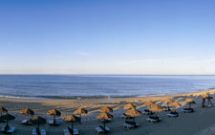Ermida de Nossa Senhora dos Anjos
Ermida de Nossa Senhora dos Anjos
Monuments
Hermitage of Nossa Senhora dos Anjos
This was possibly the first church to be built in the Azores, in the 15th century, and was subject to alterations in the 17th century.
As far as we know, Christopher Columbus's crew prayed in the Hermitage when they passed through the Azores on their return journey after discovering America in 1493.
The remnants of the primitive 15th century church include the lateral pointed arched doorway and the front porch dedicated to the worship of the Holy Spirit.
Important features of the interior include the valuable works made out of "pau-branco" (“whitewood”), a wood that existed on the island when it was first settled, including the altarpiece which according to tradition was the portable altar of the caravel in which the original settler, Gonçalo Velho, laid anchor in Santa Maria.
Other important features include the altar's polychrome azulejo-tiled frontispiece, featuring exotic creatures and birds, which was highly popular in the 17th century, surrounding the figure of São Boaventura. It was installed in 1679 during the reconstruction works, after an assault by Algerian pirates in 1616 and 1675, as recorded in one of the chapel's stones.
This was possibly the first church to be built in the Azores, in the 15th century, and was subject to alterations in the 17th century.
As far as we know, Christopher Columbus's crew prayed in the Hermitage when they passed through the Azores on their return journey after discovering America in 1493.
The remnants of the primitive 15th century church include the lateral pointed arched doorway and the front porch dedicated to the worship of the Holy Spirit.
Important features of the interior include the valuable works made out of "pau-branco" (“whitewood”), a wood that existed on the island when it was first settled, including the altarpiece which according to tradition was the portable altar of the caravel in which the original settler, Gonçalo Velho, laid anchor in Santa Maria.
Other important features include the altar's polychrome azulejo-tiled frontispiece, featuring exotic creatures and birds, which was highly popular in the 17th century, surrounding the figure of São Boaventura. It was installed in 1679 during the reconstruction works, after an assault by Algerian pirates in 1616 and 1675, as recorded in one of the chapel's stones.
Contacts
Address:
Anjos 9580 Vila do Porto
Telephone:
+351 296 884 167




 Explore
Explore 
 Remember and Share
Remember and Share 


